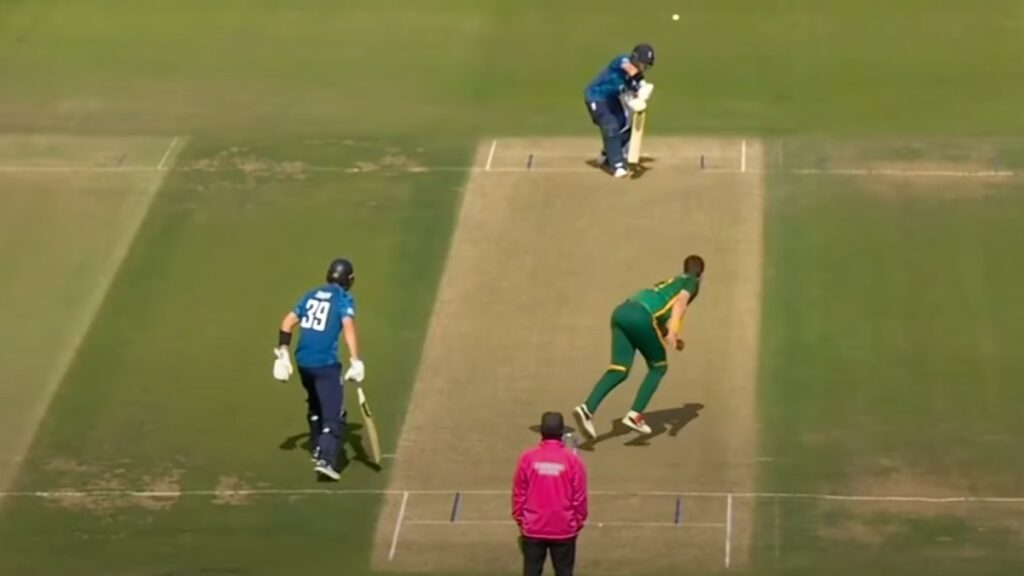🇬🇧 England vs South Africa 1st ODI at Headingley: A New Chapter Begins
The cricketing summer of 2025 kicked off in style as England hosted South Africa for the first ODI of their much-anticipated series at Headingley, Leeds. With fresh faces, strategic gambles, and a pitch that kept everyone guessing, the match was more than just a contest—it was a statement of intent from both sides.
A Debut Worth Remembering: Sonny Baker’s Big Day
For England, the day began with a heartwarming moment as Sonny Baker received his ODI cap from Jos Buttler. The young pacer from Kings Taunton, who had shared dressing rooms with Buttler at Manchester Originals, stepped onto the field with the weight of expectation and the pride of his family watching from the stands. Baker’s inclusion wasn’t just symbolic—it was tactical. England needed fresh pace, and Baker’s ability to swing the ball and maintain control under pressure made him a compelling choice.
His debut was a blend of nerves and promise. While he didn’t set the scoreboard alight, his rhythm and discipline hinted at a bright future. In a format where margins are razor-thin, Baker’s calm demeanor and sharp seam movement were a welcome addition to England’s bowling arsenal.

Toss and Tactics: Bavuma’s Calculated Gamble
South Africa’s captain, Temba Bavuma, won the toss and chose to bowl first—a decision that raised eyebrows given Headingley’s recent history favoring teams batting first. But Bavuma had done his homework. The pitch had a green tinge, and with overcast conditions forecasted, he backed his four-seamer attack to exploit early movement. England’s captain Harry Brook admitted he would’ve made the same call, underscoring the tactical symmetry between the two sides. It was a bold move, especially considering South Africa had just flown in from Australia after a grueling series. But Bavuma’s confidence in his bowlers—and perhaps in England’s vulnerability under pressure—was evident.
England’s XI: Experience Meets Youth
England’s lineup was a blend of seasoned campaigners and rising stars. Joe Root, fresh off a Hundred final just 40 hours earlier, anchored the batting order. His presence brought stability, while Ben Duckett and Jamie Smith added flair. Jos Buttler, ever the tactician, slotted in as the middle-order enforcer. The bowling unit was equally intriguing. Jofra Archer, finally injury-free after a long rehabilitation, partnered with Baker to form a pace duo that could trouble any top order. Brydon Carse added muscle, while Adil Rashid’s leg-spin offered variety. England’s strategy was clear: attack with pace, control with spin, and rely on their batting depth to post a competitive total.
South Africa’s Squad: Jet-Lagged but Hungry
Despite traveling over 16,500 kilometers from Australia, South Africa looked sharp. Their top order featured Aiden Markram and Ryan Rickelton—both in form and capable of setting the tone. Bavuma slotted in at No. 3, bringing calm and experience.
The middle order, however, was a point of concern. Tony de Zorzi and Tristan Stubbs had struggled for consistency, and their performance in this match would be crucial for South Africa’s chances. The bowling attack was pace-heavy, with Lungi Ngidi, Gerald Coetzee, and Marco Jansen leading the charge. Keshav Maharaj, the world’s top-ranked ODI bowler, was the lone spinner—a testament to South Africa’s faith in seam-friendly conditions.
Strategy Over Spectacle
This wasn’t a match defined by fireworks or collapses—it was a tactical arm-wrestle. South Africa’s decision to bowl first was vindicated early on as England’s top order struggled to find rhythm. The pitch offered movement, and the Proteas’ bowlers maintained tight lines, forcing England to grind for runs.
Joe Root’s innings was a masterclass in patience. He absorbed pressure, rotated strike, and anchored the innings while others played around him. Duckett and Smith showed glimpses of aggression, but South Africa’s fielding and bowling discipline kept them in check. England’s total was competitive, not commanding. But in ODIs, especially on tricky surfaces, even 250 can be a match-winning score.
The Chase: South Africa’s Balancing Act
South Africa’s chase began cautiously. Markram and Rickelton negotiated the new ball well, but Baker and Archer kept them honest. Bavuma’s entry stabilized the innings, and for a while, the chase looked smooth. But England’s bowlers struck back. Rashid’s variations troubled the middle order, and Carse’s pace broke partnerships. Stubbs and de Zorzi faltered under pressure, and suddenly, the chase became a scrap. Maharaj’s late cameo added drama, but England held their nerve. Buttler’s captaincy was sharp—field placements were aggressive, and bowling changes were timely. In the end, South Africa fell short, and England took a 1-0 lead in the series.
This match was more than just a win for England—it was a glimpse into the future. Sonny Baker’s debut, Archer’s return, and Root’s resilience painted a picture of a team evolving with purpose. South Africa, despite the loss, showed grit and depth. Their bowling attack is potent, and with a few tweaks in the batting order, they remain serious contenders. As the series moves forward, expect more tactical battles, individual brilliance, and moments that remind us why ODI cricket still holds a special place in the hearts of fans.

